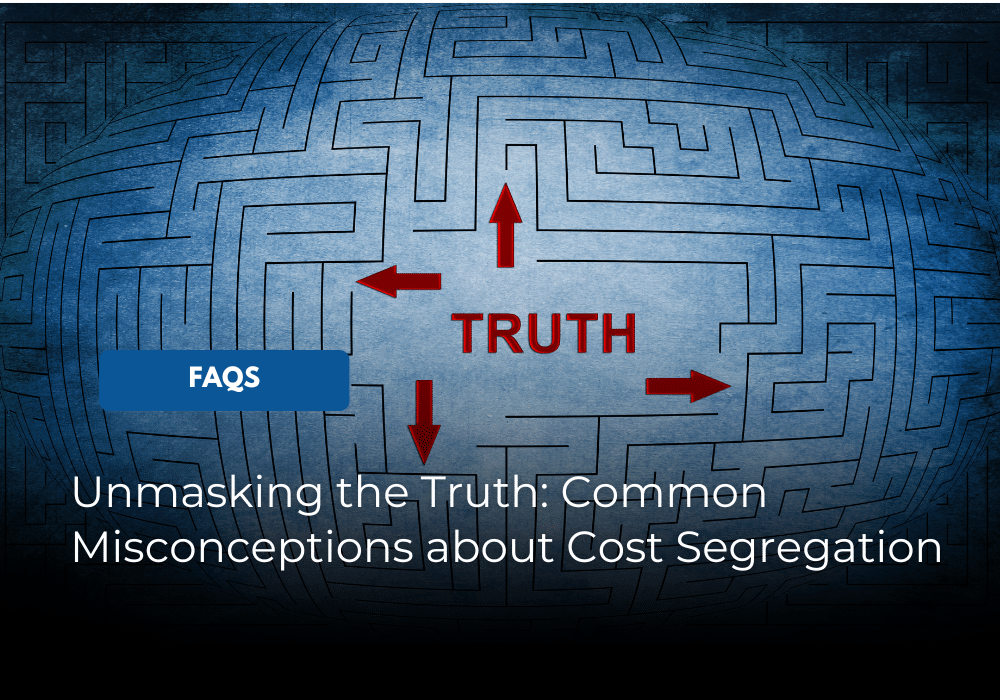In the complex world of real estate investments, maximizing profitability often hinges on effective tax strategies. One powerful but frequently misunderstood tool at the disposal of property owners is cost segregation. This method can significantly enhance cash flows by accelerating depreciation deductions, thereby deferring federal and state income taxes. Despite its benefits, many misconceptions cloud the understanding of this strategy, potentially causing investors to miss valuable opportunities. Here, we aim to demystify cost segregation, clarifying its applicability and highlighting its benefits for a diverse range of properties.
Cost segregation is a tax planning strategy that involves identifying property assets that can be reclassified into shorter depreciation time frames. Typically, commercial and residential buildings are depreciated over 27.5 to 39 years. However, cost segregation studies can reclassify portions of the building and land improvements to be depreciated over 5, 7, or 15 years, thus accelerating the depreciation deductions. This front-loading of depreciation can lead to significant tax savings in the early years of a property’s life, improving cash flow and increasing the return on investment.
6 Common Misconceptions about Cost Segregation
- Cost Segregation is Only for Large Commercial Properties
Many property owners assume that the size or cost of their property disqualifies them from realizing the benefits of cost segregation. However, properties of various types and sizes, from small residential rentals to large commercial complexes, can benefit from cost segregation. Properties with a cost basis as low as $200,000 can yield tax savings that significantly outweigh the cost of a study, making it a worthwhile consideration for nearly any business use property. - Limited to Newly Constructed Properties Construction
Contrary to common perception, cost segregation is not solely applicable to newly constructed property. It can also be effectively utilized for purchasing existing buildings and renovation costs. Additionally, business owners who lease properties can benefit from cost segregation studies on tenant improvement costs. Often, the leasehold improvements made to the interior of a commercial property can qualify as Qualified Improvement Property (QIP), resulting in a greater proportion of costs being reclassified as short-life assets (15 years or less), resulting in substantial benefits. - A Study Must be Completed in the Year of Acquisition.
Cost segregation studies can be conducted anytime, allowing property owners to use them as strategic financial tools. Studies on properties acquired in prior tax years are commonly called “catch-up” or “look-back” studies. For these existing properties, the IRS allows property owners to claim the cumulative missed accelerated depreciation in the current tax year, eliminating the need to amend previous tax returns. This adjustment, known as a 481(a) adjustment, is reported via Form 3115, and most reputable cost segregation service providers will complete this form as part of their service. - Cost Segregation Studies are Complicated and Expensive
While the process involves a detailed analysis of building components and engineering-based approaches, the property owner is not burdened with this complexity. Professional firms specializing in cost segregation handle the intricacies of the study, delivering a detailed report that maximizes potential savings while adhering to IRS guidelines. These experts ensure the process is streamlined and minimally invasive to the owner’s ongoing operations.
While the initial investment in the cost of a cost segregation study might seem high, it’s crucial to consider the substantial tax savings it can offer. By accelerating depreciation, these studies can reduce your tax liability significantly in the early years. The improved cash flow from these savings can be reinvested in your business, further enhancing your financial gain. Many firms even offer a complimentary benefit analysis, helping you understand the potential benefits without any upfront commitment. Also, the cost of a study is generally considered deductible business expenses. - The Benefits are Offset Due to Recapture Tax Upon Sale.
Recapture tax is a common objection to getting a cost segregation study, but it is often misguided and doesn’t account for several factors.
Time Value of Money: The savings gained from accelerated depreciation can be invested to earn more income. The concept of the time value of money suggests that money available now is worth more than the same amount in the future due to its potential earning capacity. Therefore, even though you might pay taxes on the recaptured depreciation at the time of sale, the benefits of having more capital to invest early on typically provide a greater financial advantage.
Tax Rate Considerations: While recapture on the building and land improvements (Sec. 1250 real property) is taxed at a maximum rate of 25%, many property owners can use the accelerated depreciation deductions to offset income subject to higher ordinary income rates.
Allocation of the Sales Price: Proper allocation of the sale can significantly reduce the recapture tax on the personal property (Sec. 1245 property) identified in a cost segregation study, as it is only subject to recapture if it is sold for a gain. - Cost Segregation is a Tax Loophole and Increases your Chance of an Audit
Cost segregation is a legitimate, IRS-approved strategy that allows property owners to accelerate depreciation on certain parts of a property, thus saving on taxes. The key to IRS approval is ensuring that the cost segregation study adheres to IRS guidelines and is conducted by qualified professionals.
The IRS has even published a guide, the “Cost Segregation Audit Techniques Guide,” which outlines how cost segregation should be performed and what documentation is required. This guide serves as a resource for taxpayers and auditors to understand and apply the principles of cost segregation correctly, ensuring that the studies meet compliance standards. As long as the study is detailed, based on sound engineering and accounting principles, and properly documented, it is typically viewed favorably by the IRS.
Advantages of Cost Segregation
Implementing cost segregation can lead to several financial benefits:
- Immediate Increase in Cash Flow: By accelerating depreciation, you reduce your taxable income and thus your taxes due in the initial years of the property’s life. This boost in liquidity can be crucial for funding operations or future investments.
- Strategic Financial Planning: Property owners can plan more effectively for future capital expenditures and investments with improved cash flow and detailed asset reports.
- Tax Time Flexibility: Cost segregation provides more flexibility in managing taxable income, which is especially useful in periods of income fluctuation.
For those considering this strategy, it is worth consulting with a cost segregation specialist to analyze your property’s potential benefits.
Contact us today to learn more or to request a no-cost benefit analysis for your property.
















